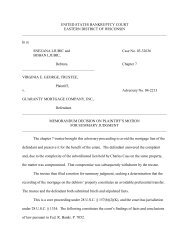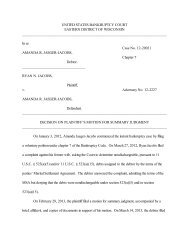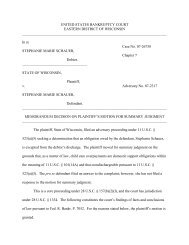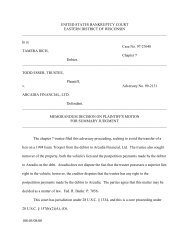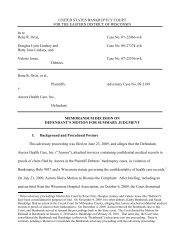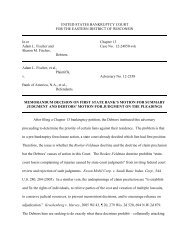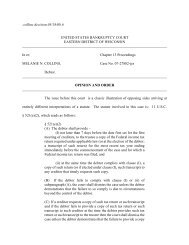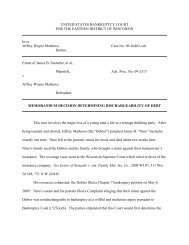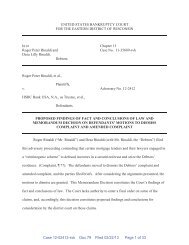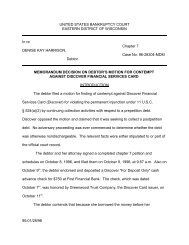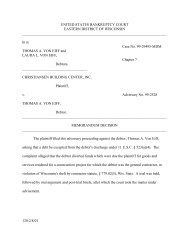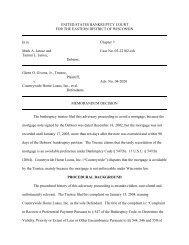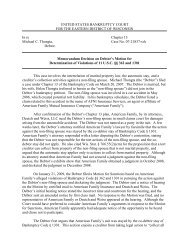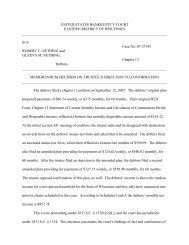In re Brad & Leanna Westenberg, Case No. 03-21749 Published
In re Brad & Leanna Westenberg, Case No. 03-21749 Published
In re Brad & Leanna Westenberg, Case No. 03-21749 Published
You also want an ePaper? Increase the reach of your titles
YUMPU automatically turns print PDFs into web optimized ePapers that Google loves.
UNITED STATES BANKRUPTCY COURT<br />
EASTERN DISTRICT OF WISCONSIN<br />
______________________________________________________________________________<br />
<strong>In</strong> <strong>re</strong><br />
<strong>Case</strong> <strong>No</strong>. <strong>03</strong>-<strong>21749</strong><br />
BRAD LEROY WESTENBERG and<br />
LEANNA MARIE WESTENBERG,<br />
Chapter 13<br />
Debtors.<br />
______________________________________________________________________________<br />
MEMORANDUM DECISION ON DEBTORS’ OBJECTION TO<br />
TRUSTEE’S MOTION TO DISMISS<br />
______________________________________________________________________________<br />
The debtors filed a petition under chapter 13 on February 10, 20<strong>03</strong>, and their plan was<br />
confirmed on October 30, 20<strong>03</strong>. On January 3, 2007, the trustee filed a motion to dismiss the<br />
case, claiming the debtors failed to provide 2005 income tax <strong>re</strong>turns and one-half of the <strong>re</strong>funds,<br />
if any, and the plan was not feasible to complete within five years. <strong>In</strong> opposition to the motion,<br />
the debtors noted their compliance with the tax <strong>re</strong>turn and <strong>re</strong>fund <strong>re</strong>qui<strong>re</strong>ments and asserted that<br />
all plan payments had been made, entitling them to a discharge.<br />
At the January 30, 2007, hearing befo<strong>re</strong> the court the trustee argued the debtors we<strong>re</strong> not<br />
entitled to a discharge because the secu<strong>re</strong>d claims filed by the United States Department of<br />
Agricultu<strong>re</strong> Farm Service Agency and M&I Marshall & Ilsley Bank had not yet been fully<br />
satisfied. The debtors asserted that according to the confirmed plan, the <strong>re</strong>maining amounts<br />
owed to FSA and M&I Bank after the 36-month plan term we<strong>re</strong> to be paid by them di<strong>re</strong>ctly.<br />
This is a co<strong>re</strong> proceeding under 28 U.S.C. § 157(b)(2)(A), and the court has jurisdiction<br />
under 28 U.S.C. § 1334. The following constitutes the court’s findings of facts and conclusions<br />
of law pursuant to Fed. R. Bankr. P. 7052.
The plan classified the claims as follows:<br />
BACKGROUND<br />
Class 1: Administrative claims, including debtors’ attorney fees.<br />
Class 2: The fully-secu<strong>re</strong>d claim of the Farm Service Agency of the United States<br />
Department of Agricultu<strong>re</strong>, secu<strong>re</strong>d by a first lien on debtors’ farm personal property, and<br />
a third lien on debtors’ <strong>re</strong>al estate.<br />
Class 3: The claim of M&I Marshall & Ilsley Bank, fully secu<strong>re</strong>d by a second lien on<br />
debtors’ farm <strong>re</strong>al estate and by a second lien on debtors’ farm personal property.<br />
Class 4: The claim of Dodge County for <strong>re</strong>al estate taxes, secu<strong>re</strong>d by a paramount lien on<br />
debtors’ <strong>re</strong>al estate.<br />
Class 5: Unsecu<strong>re</strong>d claims. This class includes the claims of all judgment holders,<br />
because the<strong>re</strong> is insufficient value in the <strong>re</strong>al estate to afford security for their claims after<br />
deduction of prior liens and debtors’ homestead exemption.<br />
(Article I, Chapter 13 Plan filed 2/24/20<strong>03</strong>). The plan further provided the following t<strong>re</strong>atment<br />
of claims:<br />
Class 1: Claims in this class shall be paid according to the terms of the Debt Service<br />
Table at the end of this Article.<br />
Class 2: This claim will be paid on a monthly basis according to the terms specified in the<br />
Debt Service Table. <strong>In</strong>te<strong>re</strong>st rates shall be fixed at the levels shown in the table.<br />
Class 3: This claim will be paid in part through sale or conveyance of debtors’ <strong>re</strong>al estate,<br />
as described in Article III he<strong>re</strong>of. The balance of the claim after such sales will be paid<br />
on a monthly basis according to the terms specified in the Debt Service Table. <strong>In</strong>te<strong>re</strong>st<br />
rates shall be fixed at the levels shown in the table.<br />
Class 4: This claim will be paid in full through sales of debtors’ <strong>re</strong>al estate, as described<br />
in Article III he<strong>re</strong>of.<br />
Class 5: Claims in this class shall be paid according to the terms of the Debt Service<br />
Table at the end of this Article. <strong>In</strong>dividual claims in the class will <strong>re</strong>ceive pro-rata<br />
payments from the fund shown as the class claim. After completion of the land sales<br />
described in Article III, the <strong>re</strong>maining claims in Classes 2 & 3 shall be determined, and<br />
the monthly payment for those classes shall be <strong>re</strong>-calculated in accordance with the terms<br />
2
specified in the table. After that step is taken, the Class 5 claim shall be set at an amount<br />
which the debtors’ <strong>re</strong>maining disposable income, less trustee’s fees, will amortize on the<br />
terms set forth in the Table.<br />
DEBT SERVICE TABLE<br />
Class<br />
1. Admin.<br />
2. USDA<br />
3. M&I Bank<br />
4. Unsecu<strong>re</strong>d<br />
Claim<br />
2,400<br />
100,000<br />
58,500<br />
12,000<br />
A m o r tP. eriod<br />
0.6<br />
25<br />
25<br />
2.4<br />
Fixed Period<br />
3<br />
3<br />
3<br />
3<br />
<strong>In</strong>te<strong>re</strong>st Rate<br />
0.0%<br />
5.0%<br />
8.0%<br />
0.0%<br />
Subtotal:<br />
Annual:<br />
Trustee:<br />
Mnthly Pymt<br />
<strong>No</strong>te 1<br />
591.27<br />
456.68<br />
416.67<br />
$1,465.62<br />
$17,587.45<br />
$1,954.16<br />
Plan payment, every two weeks: $751.60<br />
(Article II, Chapter 13 Plan filed 2/24/20<strong>03</strong>). Article III of the plan provided for payments to the<br />
trustee by wage assignment, as well as the sale of certain parcels of <strong>re</strong>al estate.<br />
The court approved the sale of two parcels of the debtors’ <strong>re</strong>al estate f<strong>re</strong>e and clear of<br />
liens, <strong>re</strong>sulting in a <strong>re</strong>duction of the balances owed FSA and M&I Bank. FSA’s objection to<br />
confirmation was <strong>re</strong>solved by a stipulation whe<strong>re</strong>in the priority of FSA’s lien was clarified and<br />
its claim was amortized over 20 years, rather than the 25 years amortization which the plan<br />
originally provided. (Stipulation between Debtors and United States of America dated<br />
September 3, 20<strong>03</strong>). The stipulation further provided that the “plan [did] not modify, exclude or<br />
lessen debtors’ <strong>re</strong>sponsibilities and ag<strong>re</strong>ements, other than any changes provided in the plan to<br />
the amounts and <strong>re</strong>payment terms, contained in the notes, mortgages, and security instruments<br />
with the Farm Service Agency.” (Stipulation between Debtors and United States of America<br />
dated September 3, 20<strong>03</strong>). The court confirmed the plan, as modified, on October 30, 20<strong>03</strong>.<br />
The secu<strong>re</strong>d claim of M&I Bank at the time of this objection was $25,935.18. (Proof of<br />
Claim no. 12, filed January 12, 2007, amending Proof of Claim no. 11). The bank had originally<br />
3
filed a proof of claim on March 6, 20<strong>03</strong>, in the amount of $210,645.69 (Proof of Claim no. 4),<br />
and after <strong>re</strong>ceiving proceeds from the sale of the <strong>re</strong>al estate, amended its secu<strong>re</strong>d claim to<br />
$35,943.86 on January 22, 2004. (Proof of Claim no. 11).<br />
FSA filed a secu<strong>re</strong>d claim in the amount of $100,242.52 on September 15, 20<strong>03</strong>. (Proof<br />
of Claim no. 10). On March 25, 2004, the debtors and the United States of America filed a<br />
stipulation of modification of plan payments whe<strong>re</strong>in the balance due on the FSA claim was<br />
<strong>re</strong>duced to $93,233.<strong>03</strong>, bearing inte<strong>re</strong>st at 5% per annum and amortized over 20 years by monthly<br />
payments of $623.43. The debtors’ total monthly plan payments <strong>re</strong>mained unchanged, with the<br />
newly available funds devoted to payment of unsecu<strong>re</strong>d claims. (Stipulation between Debtors<br />
and United States of America filed March 25, 2004; Order Modifying Plan Payments ente<strong>re</strong>d<br />
April 1, 2004). <strong>No</strong>ne of the claims of either c<strong>re</strong>ditor we<strong>re</strong> objected to by the debtors or trustee.<br />
From the beginning of the case until the time of this objection, the debtors made<br />
employer-deducted payments to the trustee in the amount of $752 bi-weekly. Along with<br />
additional funds <strong>re</strong>mitted to the trustee by way of a c<strong>re</strong>ditor <strong>re</strong>fund, income tax <strong>re</strong>funds, and a<br />
di<strong>re</strong>ct payment from the debtors, the debtors paid $94,381.92 into the plan. <strong>In</strong> turn, payments<br />
we<strong>re</strong> disbursed to Dodge County, FSA and M&I Bank, along with the administrative expenses of<br />
debtors’ counsel and the trustee.<br />
DISCUSSION<br />
Section 502(a) of the Bankruptcy Code provides that proofs of claim filed under section<br />
501(a) a<strong>re</strong> allowed unless objected to. <strong>In</strong> turn, the plan must propose to distribute property<br />
having a value, as of the effective date of the plan, at least equal to the amount of the allowed<br />
secu<strong>re</strong>d claims provided for by the plan. 11 U.S.C. § 1325(a)(5)(B)(ii). A simple comparison of<br />
4
the sum total of all payments that have been made under the debtors’ plan with the amount of the<br />
allowed secu<strong>re</strong>d claims <strong>re</strong>veals the plan payments will not pay all secu<strong>re</strong>d claims. <strong>No</strong> balloon<br />
payment at the end of the plan is provided for. If the plan we<strong>re</strong> a simple “pot plan,” our inquiry<br />
would end he<strong>re</strong> and the debtors would face either an additional period of continued plan<br />
payments or dismissal of their case for lack of feasibility. However, the plan in this case<br />
anticipated and provided for payments to secu<strong>re</strong>d c<strong>re</strong>ditors well past the term of the plan.<br />
The c<strong>re</strong>ditors in this case have not joined the trustee in his motion for dismissal,<br />
p<strong>re</strong>sumably because the plan did not <strong>re</strong>lease their liens on property <strong>re</strong>tained by the debtors, and<br />
provided for payment on their secu<strong>re</strong>d claims over a lengthy post-plan amortization period. The<br />
plan provides that sales of property a<strong>re</strong> f<strong>re</strong>e and clear of liens, with liens to attach to proceeds,<br />
but nothing <strong>re</strong>qui<strong>re</strong>s <strong>re</strong>lease of any lien on property that the debtors continue to hold. Thus, the<br />
c<strong>re</strong>ditors, to the extent they a<strong>re</strong> unpaid during the term of the plan, continue to hold liens on the<br />
debtors’ property until paid.<br />
Under section 1327(a), the plan is binding on the debtor and each c<strong>re</strong>ditor provided for by<br />
the plan as to all issues dealt with in the plan. 11 U.S.C. § 1327(a). Although the facts a<strong>re</strong><br />
decidedly diffe<strong>re</strong>nt from this case, the court is persuaded by the <strong>re</strong>asoning of the Seventh<br />
th<br />
Circuit’s ruling in Matter of Pence, 905 F.2d 1107 (7 Cir. 1990), in deciding whether all<br />
c<strong>re</strong>ditors a<strong>re</strong> bound by the terms of the confirmed plan. Pence involved a debtor who proposed a<br />
plan in which a secu<strong>re</strong>d c<strong>re</strong>ditor would <strong>re</strong>ceive property pursuant to section 1325(a)(5)(B)(ii) of a<br />
value g<strong>re</strong>ater than the secu<strong>re</strong>d c<strong>re</strong>ditor’s claim in exchange for a <strong>re</strong>lease of the c<strong>re</strong>ditor’s lien.<br />
The plan was confirmed without objection. When it became appa<strong>re</strong>nt that the property provided<br />
to the secu<strong>re</strong>d c<strong>re</strong>ditor had a value less than the allowed amount of the c<strong>re</strong>ditor’s claim, the<br />
5
secu<strong>re</strong>d c<strong>re</strong>ditor attempted to enforce its lien. The court held that the c<strong>re</strong>ditor was bound by the<br />
provisions of the confirmed plan. Id. at 1110. The court add<strong>re</strong>ssed a due process argument,<br />
stating that notice of the filing of a chapter 13 petition was sufficient, in and of itself, to put the<br />
c<strong>re</strong>ditor on notice that its rights may be alte<strong>re</strong>d. Id. at 1109. The c<strong>re</strong>ditor had an affirmative duty<br />
to monitor the proceeding to determine what aspects of the case the c<strong>re</strong>ditor may have wanted to<br />
challenge. Id. The court stated that the c<strong>re</strong>ditor was “not entitled to stick its head in the sand and<br />
p<strong>re</strong>tend it would not lose any rights by not participating in the proceedings.” Id. at 1109; see also<br />
th<br />
<strong>In</strong> <strong>re</strong> Harvey, 213 F.3d 318 (7 Cir. 2000) (holding that, to extent plan was ambiguous to<br />
c<strong>re</strong>ditor, it should have objected befo<strong>re</strong> plan confirmation).<br />
<strong>No</strong>twithstanding its prior determinations, in a controversial later decision, the Seventh<br />
Circuit held that a confirmed chapter 13 plan was not entitled to any <strong>re</strong>s judicata effect. <strong>In</strong><br />
th<br />
Matter of Escobedo, 28 F.3d 34 (7 Cir. 1994), a chapter 13 plan that did not include allowed<br />
administrative and tax priority claims as <strong>re</strong>qui<strong>re</strong>d under section 1322(a)(2) was confirmed<br />
without objection. Nearly five years after plan confirmation and two years after the debtor’s final<br />
payment, the trustee petitioned the court to either modify the plan’s payment schedule to include<br />
the al<strong>re</strong>ady allowed administrative and tax priority claims, or dismiss the plan altogether. The<br />
debtor did not modify the plan and the bankruptcy court dismissed the enti<strong>re</strong> case. The district<br />
court affirmed. The Seventh Circuit also affirmed, holding that because the debtor’s proposed<br />
plan did not comply with the mandatory provision of section 1322(a)(2), “any supposed<br />
confirmation was nugatory and properly dismissed.” Id. at 35. Accordingly, the court held that<br />
the confirmed plan was not binding as to the omitted priority claims. Appa<strong>re</strong>ntly, the Seventh<br />
Circuit has drawn a distinction between an order confirming a chapter 13 plan that did not meet<br />
6
the disc<strong>re</strong>tionary <strong>re</strong>qui<strong>re</strong>ments of section 1325(a)(5), and a plan that did not meet the mandatory<br />
statutory <strong>re</strong>qui<strong>re</strong>ments of section 1322(a)(2). Id. P<strong>re</strong>sumably, the former would not be nugatory.<br />
The appellate courts have differing opinions on the whole “claim controls” versus “plan<br />
controls” issue. Some have held a provision of a confirmed plan cannot alter a claim filed by a<br />
c<strong>re</strong>ditor because section 502(a) provides that a filed proof of claim is deemed allowed absent<br />
th<br />
objection. See, e.g., <strong>In</strong> <strong>re</strong> Bateman, 331 F.3d 821 (11 Cir. 20<strong>03</strong>) (holding c<strong>re</strong>ditor’s claim for<br />
mortgage ar<strong>re</strong>arage survived confirmed plan to extent it was not satisfied); <strong>In</strong> <strong>re</strong> Simmons, 765<br />
th<br />
F.2d 547 (5 Cir. 1985) (holding when no objection was filed to c<strong>re</strong>ditor’s proof of secu<strong>re</strong>d claim<br />
prior to confirmation, the claim was deemed allowed as a secu<strong>re</strong>d claim, even though plan t<strong>re</strong>ated<br />
it as unsecu<strong>re</strong>d and the<strong>re</strong> had been no objection to the plan). Other courts of appeal have held<br />
that a confirmed plan cannot alter the rights of a c<strong>re</strong>ditor that has filed a secu<strong>re</strong>d proof of claim<br />
unless that c<strong>re</strong>ditor <strong>re</strong>ceives specific notice that the debtor seeks to <strong>re</strong>duce the value of its<br />
th<br />
allowed secu<strong>re</strong>d claim in the confirmation process. E.g., <strong>In</strong> <strong>re</strong> Linkous, 990 F.2d 160 (4 Cir.<br />
th<br />
1993). It should also be noted that in <strong>In</strong> <strong>re</strong> Hovis, 356 F.3d 820 (7 Cir. 2004), the Seventh<br />
Circuit held that the chapter 11 debtor was not judicially estopped from objecting,<br />
postconfirmation, to a proof of claim.<br />
The court’s Pence ruling appears to establish the principle that notice of filing a chapter<br />
13 petition as sufficient notice per se. <strong>No</strong>tice of the filing of a petition imposes on the secu<strong>re</strong>d<br />
c<strong>re</strong>ditor a duty to inqui<strong>re</strong> about the alteration of its rights under any proposed chapter 13 plan.<br />
Thus, the crucial question for this court appears to be: Did the c<strong>re</strong>ditors <strong>re</strong>ceive adequate notice<br />
of their rights under the plan<br />
Clearly, the plan spelled out the amortization periods of the secu<strong>re</strong>d claims and the<br />
7
c<strong>re</strong>ditors we<strong>re</strong> not fooled by the plan’s t<strong>re</strong>atment of their claims. <strong>In</strong> fact, FSA was an active<br />
participant in the confirmation process and subsequent plan modification. M&I Bank also filed<br />
amended claims as the amount due was paid down by sales pursuant to the plan. While the<br />
claims show that amounts a<strong>re</strong> still owed, the c<strong>re</strong>ditors have <strong>re</strong>ceived payments as the plan<br />
provided, and the amortization period in the plan <strong>re</strong>qui<strong>re</strong>s that they will continue to <strong>re</strong>tain their<br />
liens and <strong>re</strong>ceive payments after the term of the plan. Under these circumstances, this court finds<br />
the debtors fully complied with the confirmed plan and a<strong>re</strong> entitled to a discharge. The debtors’<br />
objection is sustained and the trustee’s motion to dismiss is denied. A separate order consistent<br />
with this decision will be ente<strong>re</strong>d.<br />
March 30, 2007<br />
Marga<strong>re</strong>t Dee. McGarity<br />
Chief Judge, U.S. Bankruptcy Court<br />
8



